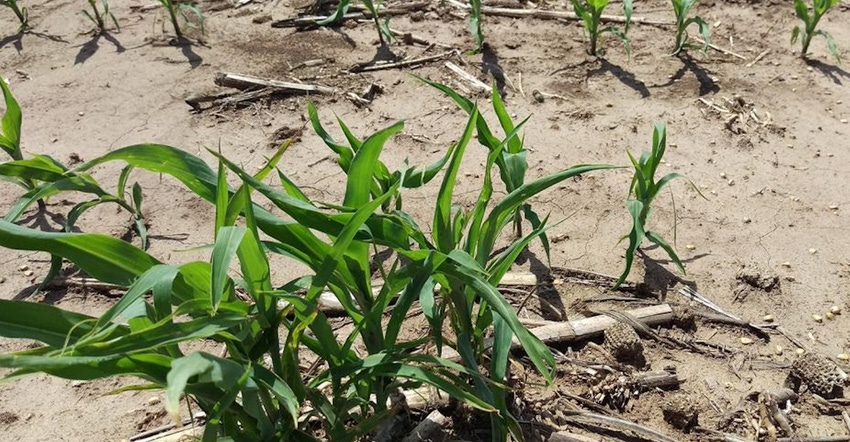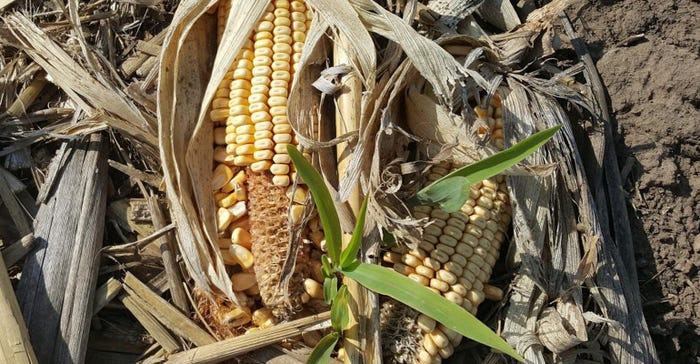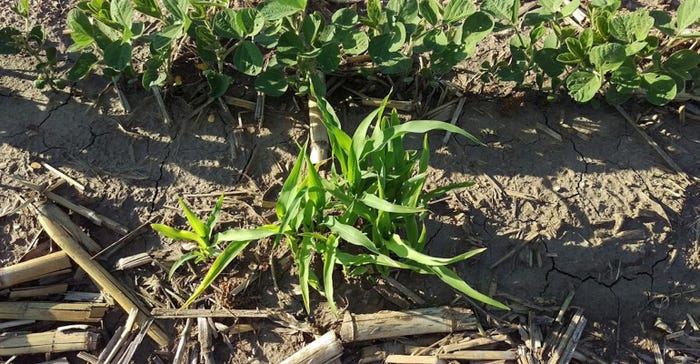June 12, 2018

By Amit Jhala and Jenny Rees
Wind storms last fall led to downed corn in many areas of the state. These losses, along with harvest losses, are contributing to widespread problems with volunteer corn in crop fields. This is despite grower efforts to manage the impending problem through postharvest grazing and tillage of the fields. Depending on density, this volunteer corn may reduce crop yield if not controlled.
Volunteer corn actually impacts soybean, dry bean and sugarbeet yields more than corn yields. This is perhaps due to the different growth structure of soybean, dry bean, and sugarbeet compared to corn. To envision the densities mentioned below, assuming 30-inch rows, a thousandth of an acre is 17 feet, 5 inches. Thus, densities of 3,500, 5,000 and 7,000 plants per acre would result in three and a half, five and seven corn plants, respectively, in a thousandth of an acre.
Soybeans
Various research has been done on volunteer corn’s effect on soybeans:
• University of Nebraska-Lincoln research found a volunteer corn density of 3,500 plants per acre led to 10% yield reduction in soybean. Doubling the density to 7,000 plants per acre led to a 27% yield reduction.
• South Dakota State University data revealed similar trends. A volunteer corn density of 5,000 plants per acre resulted in a 20% yield reduction (12 bushel per acre yield loss in 60 bushel per acre soybean).
• Clumps of volunteer corn in soybean led to greater yield loss, as they were more competitive than individual plants. In the UNL study, a density of 3,500 clumps of corn per acre resulted in a 40% yield reduction.
• Researchers in Minnesota and Illinois also found increased competition with clumps of volunteer corn versus individual plants. Clumps of corn (seven to 10 plants per clump) were established at different densities. Depending on the location and year, soybean yield was reduced 1% for every 75 to 115 clumps per acre.
• A recent UNL research study found highest yield reduction occurred when volunteer corn was left uncontrolled or when it was controlled too late at the R2 soybean growth stage. The combined density at this greatest yield reduction was at 24,710 volunteer corn plants per acre plus 1,235 volunteer corn clumps per acre.
Corn
Volunteer corn’s impact on corn includes the following:
• UNL research found a volunteer corn population of 3,500 plants per acre resulted in a 2% yield reduction in corn. Doubling the density to 7,000 plants per acre caused a 5% yield reduction.
• Clumps of volunteer corn led to greater yield loss as they were more competitive than individual plants. A density of 7,000 clumps of corn per acre resulted in a 14% yield loss compared to a 5% yield loss with individual plants.
Dry edible bean and sugarbeets
Both dry edible beans and sugarbeets were found to be greatly affected by volunteer corn:
• UNL research found dry bean yields were reduced 45% with a volunteer corn population of 5,000 plants per acre.
• University of Wyoming research found a 51% yield reduction in sugarbeet with a volunteer corn population of 3,500 plants per acre.
Volunteer corn control in soybean
Control of volunteer corn in soybean is easier because a number of graminicides (grass herbicides), such as Select Max, Poast, Assure II, Fusilade and Fusion are labeled for this use. For more information on application rates of grass herbicides for control of volunteer corn in Roundup Ready or Xtend Soybean, see Volunteer Corn in Soybean: Impact and Management.
LibertyLink soybean is also available in the marketplace and Liberty can control volunteer corn, but only if the hybrid corn planted last year was not LibertyLink-resistant. Liberty is a nonselective, contact, postemergence herbicide for broad-spectrum weed control in LibertyLink soybean. An update to the Liberty label allows a maximum cumulative rate of 87 fluid ounces per acre per growing season. Two applications, each of 32 to 43 fluid ounces per acre, could be made in LibertyLink soybean.
 HIGHER YIELD LOSS: Clumps of volunteer corn were found to cause higher yield losses in soybean than individual volunteer corn plants.
HIGHER YIELD LOSS: Clumps of volunteer corn were found to cause higher yield losses in soybean than individual volunteer corn plants.

For more information on application rates of Liberty for control of volunteer corn, see Control of Glyphosate-Resistant Volunteer Corn in LibertyLink Soybean.
Remember that Liberty can only be applied in LibertyLink soybean not in Roundup Ready or Roundup Ready 2Xtend soybean. Application of graminicides (Assure II, Select Max, Poast, Fusilade, Fusion) will be the only option for controlling volunteer corn in Roundup Ready or Roundup Ready 2Xtend soybean.
Volunteer corn control in corn
Control of volunteer corn in continuous corn is difficult because volunteer corn is also selective to corn herbicides.
 VOLUNTEER SPROUTING: Volunteer corn sprouts from ears that fell after heavy wind storms late last fall.
VOLUNTEER SPROUTING: Volunteer corn sprouts from ears that fell after heavy wind storms late last fall.

If only a Roundup Ready corn hybrid was planted the previous year and Roundup Ready + LibertyLink hybrid corn is planted this year, Liberty can be applied for control of glyphosate-resistant volunteer corn. Two applications, each of 32 to 43 fluid ounces per acre, could be made in LibertyLink corn.
Liberty will not be effective if Roundup Ready + LibertyLink hybrid corn was planted last year.
Volunteer corn control in Enlist corn
Enlist Corn is a new multiple herbicide-resistant corn. Enlist corn is resistant to 2,4-D choline, glyphosate, and aryloxyphenoxypropionates (FOPs), an acetyl CoA carboxylase (ACCase) inhibitor. Enlist corn is commercially available for the first time for the 2018 growing season. If Enlist corn is grown this year in a field that was under Roundup Ready/LibertyLink corn last year, volunteer corn can be controlled by applying FOPs.
Assure II is the only grass herbicide labeled to control volunteer corn in Enlist Corn. It can be applied at 5 to 12 fluid ounces per acre in Enlist Corn for selective control of volunteer corn. Assure II must include crop oil concentrate (1% volume/volume) or nonionic surfactant (0.25% volume/volume). Apply Assure II to emerged Enlist field corn that is at the V2 through V6 stage of development.
The applicator must always maintain a 36-foot downwind buffer between the last treated row and the nearest downwind field edge (in the direction the wind is blowing).
Remember that Assure II can’t be applied in Roundup Ready/LibertyLink corn. To know more about application requirements of Assure II, see the product label.
This report comes from UNL CropWatch.
You May Also Like




